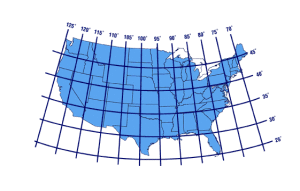Light
-

Latitude and longitude of the contiguous United States.
Shadows are cast by the structure’s frame
- Orientation to optimize for light is not as critical for a high tunnel as it is for a greenhouse structure that will be used for winter production and has a more substantial frame
- Above 40°N latitude, orient the length of a single high tunnel east to west
- This orientation allows low angle light from the winter sun to enter from the side where it will not be blocked by ribs of the frame
- Below 40°N latitude, orient the length of a single high tunnel north to south
- This orientation is acceptable because the angle of the winter sun is much higher at these latitudes
- Gutter-connected greenhouses at all latitudes should be oriented north to south
- This orientation avoids the shadow that would occur from the greenhouse just to the south of it in an east-west layout
Wind Direction
- Air flow is used to modulate temperature and relative humidity in the high tunnel through ventilation of the end and side walls
- Single bay high tunnels can be oriented perpendicular to prevailing winds to accommodate maximum air flow if structure has roll-up sides
- Multi-bay high tunnels should be oriented parallel to prevailing winds
- Prevailing winds are generally from the south-west in the summer and from the north in the winter, but specifics must be determined for each site
- Windbreaks can be used to moderate or redirect wind
- Sites located within 15,000 feet of large open bodies of water are exposed to very severe winds:
Structural Considerations and Loads
- Loads are stresses to the structure from external or internal forces
- Commercial greenhouses are required to meet structural standards to withstand various loads
- In contrast, high tunnels are generally not required to meet structural standards, which is one reason why they are inexpensive
- Specifications are in place for high tunnels in some countries such as Holland
- However, high tunnel structures should be built strong enough to withstand severe weather
- Dead loads are gravity loads that are constant throughout the structure’s life
- These include fixed equipment such as fans, suspended heaters, and water pipes, however, these are typically not found in high tunnels
- Long term crops that are suspended from the frame, such as trellised tomatoes, are often considered dead loads
- Live loads are temporaryorshort term
- These include wind loads, snow loads or any other environmental stress
- Short term crops such as hanging baskets (though not usually produced in high tunnels) are considered live loads
- Wind loads can come from any direction but usually act against the side walls by hitting them at a perpendicular angle
- Basic wind speeds for greenhouse structural designs are 90 mph for most of the US; high tunnel structures are generally not framed to withstand gusts of this magnitude
- 44 mph wind creates a live load of 5 psf (pounds per square foot)where as 62 mph wind creates a 10 psf live load
- Strong seasonal winds are a concern
- High tunnels placed perpendicular to prevailing winds typically receive the most damage
- Basic wind speeds for greenhouse structural designs are 90 mph for most of the US; high tunnel structures are generally not framed to withstand gusts of this magnitude
- Wind uplift could result in the high tunnel structure being lifted out of the ground
- The lightweight hoop structure acts like an airplane wing that creates uplift when air passes over it
- Values for wind uplift should ideally not exceed the structure’s dead load
- The best protection against uplift is to ensure that posts are driven at least 24 inches into the ground
- Snow loads are determined by factors influencing snow and ice accumulation on the structure
- Many high tunnel structures are not under production during winter
- Snow loads vary considerably by geographic location
- Snow with a one inch rain equivalent will load a structure with 5.2 psf (pounds per square foot)
- One inch rain may equal 12 inches of light, fluffy snow or 2 to 4 inches of heavy, wet snow
- A high tunnel built from ribs of 20 foot pipe bent to create a 14 foot wide X 6 foot high structure will withstand only about 10 psf
- Other factors influencing snow accumulation include building exposure, roof slope, and heat loss (from the heating system) through the roof
- If snow loads are heavy, various strategies can be used to minimize damage
- Orient the structure so prevailing winds blow the snow off the high tunnel
- Remove the plastic in the winter if not under production
- Utilize portable heaters to melt the snow load
- Manually remove snow, for example, brush from the inside using a long-handled broom
- Combination loads from more than one loading factor are common
- For example, high winds may be associated with a snowstorm




